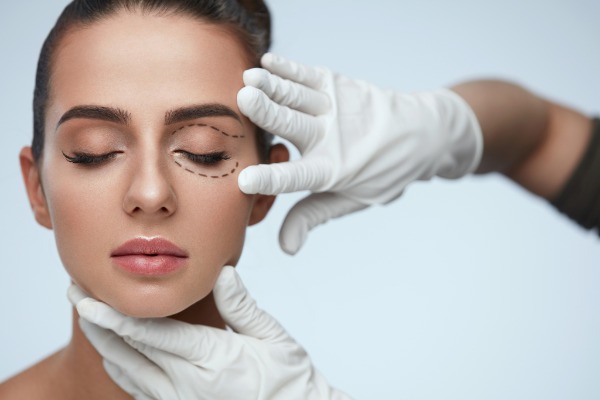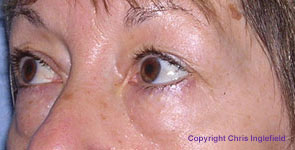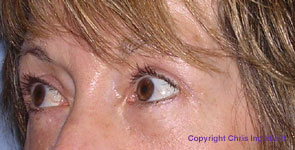
Procedure Time: 1 - 2 hours
Recovery Time: 1 week to 10 days
Results Duration: 5+ years, depending on natural ageing
Cost: Approx. £1,500 - £2,500 for upper lid surgery, £2,000 - £3,000 for lower lid surgery, £3,000 - £4,500 for combined
Anaesthesia: Local anaesthesia, sedation or general anaesthesia
For a full list of FAQs please Click Here.
Blepharoplasty or eyelid/eyebag surgery can help restore a more youthful appearance by tightening droopy or hooded eyelids, restoring the smooth line of the eyelids, and removing or moving fatty pouches beneath the eyes or "bags". It cannot, however, remove dark circles under the eyes, lift sagging eyebrows (a browlift will do this), or smooth fine wrinkles or crow's feet from around the eyes. It is often our eyelids which show the signs of ageing first which is why this can be the first cosmetic treatment which a man or a woman might choose. Eyelid surgery is generally performed under a local anaesthetic, but some patients are given sedation via an intravenous drip or a general anaesthetic. Most people find that they are ready to go out in public and be seen in around a week to 10 days. It is unlikely that anyone considering upper or lower eyelid surgery would be able to access this free of charge on the National Health Service (NHS). Private costs for blepharoplasty can range from approximately £1,500 - £2,500 for upper lid surgery only, £2,000 - £3,000 for lower lid surgery only, and £3,000 - £4,500 for upper and lower lid combined.
Do you have a question? Ask one of our experts NOWUpper and lower eyelid surgery or blepharoplasties are the 5th most common surgical procedure in the U.S. with 113,229 procedures performed in 2019. This represents a decrease of 2.0% on 2018 figures, and a decrease of 8.8% on the number of operations originally recorded for the procedure in 2015, when it was the 4th most popular surgical procedure, according to statistics from the American Society for Aesthetic Plastic Surgery (ASAPS).
As we age, our skin can become thinner and less stretchy. Our muscles can weaken and fat that cushions the eyeball moves forward through spaces in the muscle around the eyes, causing "bags". Sagging upper eyelids may result in a “hooded” appearance over the eyes. In severe cases of eyelid hooding, vision can be affected.
It is often our eyelids which show the signs of ageing first which is why this can be the first cosmetic treatment which a man or a woman might choose. Eyelid surgery can help restore a more youthful appearance by tightening droopy or hooded eyelids, restoring the smooth line of the eyelids, and removing or moving fatty pouches beneath the eyes.
Some people suffer from eyebags, caused by pseudohernias of fat (which is fat pushing through the wall of the eye muscle) at a young age. This tends to be hereditary (an inherited condition from within the family) and can be corrected with a lower eyelid blepharoplasty.
Blepharoplasty, however, cannot remove dark circles under the eyes caused by dark pigmentation of the skin or by very thin, translucent (“see-through”) skin. It does not smooth fine lines and wrinkles around the eye or "crows' feet". It cannot lift sagging eyebrows either.
Low eyebrows can only be raised in a brow lift operation.
Blepharoplasties are sometimes performed alongside a brow (forehead) lift or face lift. It can also be combined with laser skin resurfacing or a chemical peel to smooth wrinkles, or with botulinum toxin injections to produce a better final overall result.
If you are considering eyelid surgery, the following information will give you a basic understanding of the procedure. It can't answer all your questions, since a lot depends on the individual patient and the surgeon.
Please ask a surgeon about anything you don't understand.
It is very important that you follow the advice of your surgeon carefully after your treatment.
Post - surgery advice may include:
The eyes can be uncomfortable and swollen following surgery to your eyelids. The pain usually stops a few days after the surgery, but swelling may persist for over two weeks.
Other risks or complications following blepharoplasty include some minor and temporary difficulties such as:
temporary blurred vision; dry or gritty eyes; temporary problems with too much tear production; difficulty closing the eyelids completely.
The following are more serious but unusual difficulties following eyelid surgery: infection; bruising; a reaction to the anaesthetic; nerve damage; the occurrence of asymmetries (i.e. the eyes looking lop-sided) or irregularities in the eyelid.
A more serious, but very rare side effect, is bleeding behind the eye (retrobulbar haematoma).
Only fully trained and qualified Surgeons should perform a Blepharoplasty or Eyelid Surgery procedure.
For more information about practitioner training, qualifications and relevant medical organisations please view the information contained within the Legislation section of the Consulting Room.
It is unlikely that anyone considering upper or lower eyelid surgery would be able to access this free of charge on the National Health Service.
However certain regions do make special cases, especially in situations where hooding of the upper eyelid is impairing your vision. We would always recommend that you visit your General Practitioner before embarking upon a cosmetic procedure involving surgery.
As well as their advice and guidance they may also be able to refer you to a local NHS Hospital who can treat you.
The NHS has set out the following guidelines on how to get cosmetic surgery through the NHS:
"To qualify for surgery on the NHS you must meet specific criteria as set out by your local health authority. The NHS will not pay for surgery for cosmetic reasons alone. Reconstructive and cosmetic surgery to correct, or improve, congenital abnormalities and injuries will usually be carried out free of charge.
NHS reconstructive surgery is performed by plastic surgeons who have had extensive training and belong to the British Association of Plastic Reconstructive and Aesthetic Surgeons. Surgeons who carry out cosmetic surgery through the NHS also belong to the British Association of Aesthetic Plastic Surgeons.
To receive cosmetic surgery from the NHS, you will normally need a referral from your GP. You will have a consultation with a plastic surgeon and an assessment by a psychiatrist, or psychologist. It will then be decided whether there is enough social, psychological, or physical benefit to be gained to justify surgery."
Blepharoplasty, or upper and lower eyelid surgery is a very common procedure that can make quite a dramatic difference to your appearance, especially if you have large bags underneath your eyes.
Although surgery is involved, a local anaesthetic reduces risks, and in the hands of a skilled surgeon there are generally few problems after this operation.
Please note that results of cosmetic surgery vary enormously, depending upon both the patient and the skill of the individual surgeon, so outcomes for procedures will always be more variable than those for less invasive non-surgical treatments.
(All before and after photographs featured are real patients treated by highly experienced surgeons, your results may differ).


Lower eyebags clearly visible before surgery (left) and 3 months after blepharoplasty surgery (right).
Photographs courtesy of Consultant Plastic Surgeon, Mr Christopher Inglefield, BSc, MBBS, FRCS (Plast) at London Bridge Plastic Surgery.